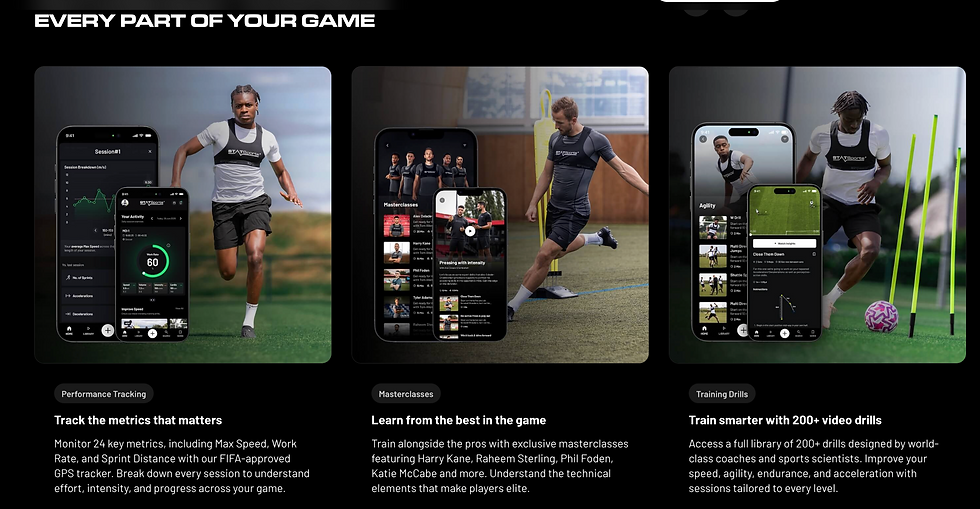The fitness levels required to play professional football in the UK or Europe
- Ian McClurg - MSc Performance Coaching

- Jun 3
- 3 min read
To play professional football (soccer) in the UK or Europe, athletes must meet extremely high fitness standards.
From my experience, few players in North America adequately prepare for training or formal trials opportunities at professional clubs in the UK or Europe.
It is difficult to successfully compete against academy players at professional clubs who are training full-time (12-16+ hours/week) if you are playing at club level in North America and training at less intensity and playing in leagues that are not as competitive as academy leagues in the UK and Europe.
He help our players prepare for training and formal trials opportunities in the UK and Europe, we offer players an opportunity to follow the strength and conditioning program used by our UK parter club Larne FC for their U16 - U18 academy players.
Simply put, the players who have the discipline and daily motivation to follow this online training program will give themselves a realistic opportunity to succeed in training or formal trials at professional clubs - the others will not.
Learn more about training like a professional player here

Below is a breakdown of the key fitness components and the expected levels that will be required to play professional football in the UK or Europe:
🔹 1. Aerobic Fitness (Endurance)
Requirement: Extremely high.
Why: Players cover 10–13 km per match, with continuous movement and repeated sprints.
Benchmarks:
VO2 max: 60–75 ml/kg/min (top-tier professionals)
Yo-Yo Intermittent Recovery Test (Level 1): 20.5+ for outfield players
🔹 2. Anaerobic Fitness (High-intensity bursts)
Requirement: Very high.
Why: Sprints, accelerations, and explosive efforts are constant, especially in transitions.
Benchmarks:
Repeated Sprint Ability (RSA): Maintain <5% drop-off over 6–10 maximal sprints
30m sprint time: Elite pros clock 3.7–4.0 seconds
🔹 3. Strength & Power
Requirement: High, especially for defenders and forwards.
Why: Shielding, tackling, jumping, and holding off opponents require strong musculature.
Benchmarks:
Squat: 1.5–2x body weight (1RM)
Vertical jump: 55–65 cm+ (elite levels)
Countermovement jump: Used as a key metric in clubs
🔹 4. Speed & Agility
Requirement: Elite level.
Why: Frequent changes in direction, acceleration, and top-end speed are essential.
Benchmarks:
5m sprint: ~1.0–1.2 sec
10m sprint: ~1.7–1.9 sec
40m sprint: ~5.0–5.3 sec
Agility tests (e.g., T-test): ~9–10 sec
🔹 5. Mobility & Flexibility
Requirement: Moderate to high.
Why: Injury prevention and technical execution (e.g., reaching for balls, kicking range)
Regular mobility routines and functional movement assessments are standard.
🔹 6. Body Composition
Requirement: Lean, powerful physique.
Why: To balance speed, endurance, and strength without excess mass.
Benchmarks:
Body fat percentage:
Outfield players: 6–11%
Goalkeepers: 8–13%
⚽️ Position-Specific Fitness (Examples)
Position | Key Fitness Emphasis |
Wingers | Sprint speed, agility, endurance |
Central Midfielders | Aerobic capacity, strength, agility |
Centre Backs | Strength, aerial power, anaerobic |
Fullbacks | Endurance, pace, recovery runs |
Forwards | Explosiveness, finishing speed |
📊 Summary: Typical Daily Training at Pro Clubs
Strength & Conditioning: 2–4x per week
Tactical/Technical Sessions: Daily
Recovery Sessions: Ice baths, massage, nutrition
Fitness Testing: Regular throughout season
If aspire to reach professional levels, get in touch to learn more about how you can train monthly online, like an academy player at a professional club in the UK and Europe.
If you can reach the required levels, we can assist with setting up trials for you during 2025.


